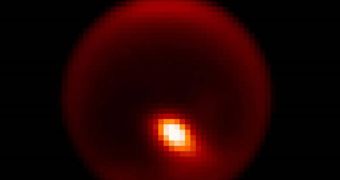Last summer, as experts pointed their telescopes towards Saturn's moon Titan, they noticed a peculiar appearance on the surface of the body. It seemed as if a full-scale tropical storm was underway at its equator, in a manner eerily similar to how these formations look like back on Earth. In fact, the entire moon is strange, astronomers say, because the body resembles our planet a lot, yet differs in some key aspects, such as the fact that its natural cycles feature methane instead of oxygen, carbon and water.
Recent investigations have revealed that most of the formations we would expect from an environment in deep space are met. For instance, the moon has lakes, clouds and rain, with the sole exception that these are made up of methane and other hydrocarbons, instead of water. The chilling temperatures on Titan, which revolves around its planet and the Sun at a far greater distance than the Earth does, would undoubtedly turn any traces of water on its surface into rock-hard ice, LiveScience informs.
Before April 2008, when these observations were made, there was no evidence to suggest that methane might be at Titan's equator, although ample evidence of the gas existed elsewhere on the moon. The phenomenon was observed with NASA's Infrared Telescope Facility, in Hawaii, as well as with the Gemini North telescope, while the latter was using the adaptive optics imaging method. According to the readings, the storm was covering an area of about 2 million square miles (3 million square kilometers) next to the moon's equator.
“The models predicted that the equatorial region should be very dry and should not support cloud formation. But this episode created clouds over both the equator and the south pole. We don't know what set off that sequence, but something gave a pretty good kick to the atmosphere,” says Lowell Observatory astronomer Henry Roe, from Arizona, quoted by Space. “It's an amazing place because it is deeply familiar to us, being from Earth, in terms of the processes – clouds forming, rainfall, carved out channels on the surface, huge fields of what look like sand dunes. But the materials that are involved are quite alien.”
The expert also states that the storm clouds, once formed, started to stretch over the surface of Titan in wave-like ripples, and that this event brings up a new set of questions, to be added to others that still remain unanswered. One possible trigger for the new events may have been of a geological nature, astronomers believe. They say that the formation of a new mountain range, or perhaps a powerful volcanic eruption, may have altered the existing balance in the atmosphere, and created the storm.
“We really need to keep observing Titan in detail for many more years in order to get a true understanding of how its seasons change,” Roe adds. The team's finds appear in the August 13th issue of the respected scientific journal Nature.

 14 DAY TRIAL //
14 DAY TRIAL //